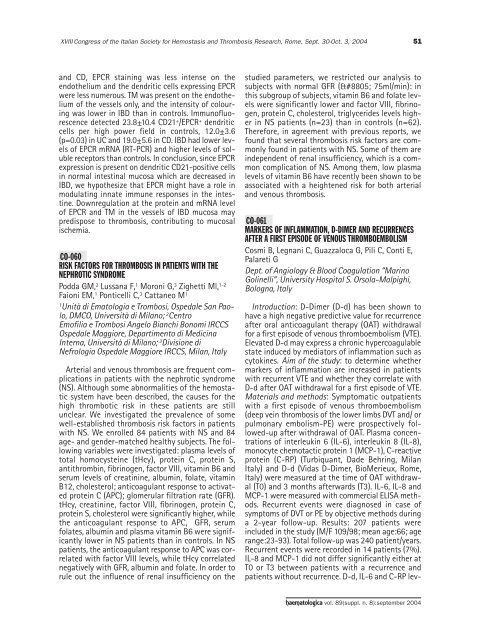Haematologica 2004;89: supplement no. 8 - Supplements ...
Haematologica 2004;89: supplement no. 8 - Supplements ...
Haematologica 2004;89: supplement no. 8 - Supplements ...
- No tags were found...
You also want an ePaper? Increase the reach of your titles
YUMPU automatically turns print PDFs into web optimized ePapers that Google loves.
XVIII Congress of the Italian Society for Hemostasis and Thrombosis Research, Rome, Sept. 30-Oct. 3, <strong>2004</strong>51and CD, EPCR staining was less intense on theendothelium and the dendritic cells expressing EPCRwere less numerous. TM was present on the endotheliumof the vessels only, and the intensity of colouringwas lower in IBD than in controls. Immu<strong>no</strong>fluorescencedetected 23.8±10.4 CD21 + /EPCR + dendriticcells per high power field in controls, 12.0±3.6(p=0.03) in UC and 19.0±5.6 in CD. IBD had lower levelsof EPCR mRNA (RT-PCR) and higher levels of solublereceptors than controls. In conclusion, since EPCRexpression is present on dendritic CD21-positive cellsin <strong>no</strong>rmal intestinal mucosa which are decreased inIBD, we hypothesize that EPCR might have a role inmodulating innate immune responses in the intestine.Downregulation at the protein and mRNA levelof EPCR and TM in the vessels of IBD mucosa maypredispose to thrombosis, contributing to mucosalischemia.CO-060RISK FACTORS FOR THROMBOSIS IN PATIENTS WITH THENEPHROTIC SYNDROMEPodda GM, 2 Lussana F, 1 Moroni G, 3 Zighetti Ml, 1-2Faioni EM, 1 Ponticelli C, 3 Cattaneo M 11Unità di Ematologia e Trombosi, Ospedale San Paolo,DMCO, Università di Mila<strong>no</strong>; 2 CentroEmofilia e Trombosi Angelo Bianchi Bo<strong>no</strong>mi IRCCSOspedale Maggiore, Departimento di MedicinaInterna, Università di Mila<strong>no</strong>; 3 Divisione diNefrologia Ospedale Maggiore IRCCS, Milan, ItalyArterial and ve<strong>no</strong>us thrombosis are frequent complicationsin patients with the nephrotic syndrome(NS). Although some ab<strong>no</strong>rmalities of the hemostaticsystem have been described, the causes for thehigh thrombotic risk in these patients are stillunclear. We investigated the prevalence of somewell-established thrombosis risk factors in patientswith NS. We enrolled 84 patients with NS and 84age- and gender-matched healthy subjects. The followingvariables were investigated: plasma levels oftotal homocysteine (tHcy), protein C, protein S,antithrombin, fibri<strong>no</strong>gen, factor VIII, vitamin B6 andserum levels of creatinine, albumin, folate, vitaminB12, cholesterol; anticoagulant response to activatedprotein C (APC); glomerular filtration rate (GFR).tHcy, creatinine, factor VIII, fibri<strong>no</strong>gen, protein C,protein S, cholesterol were significantly higher, whilethe anticoagulant response to APC, GFR, serumfolates, albumin and plasma vitamin B6 were significantlylower in NS patients than in controls. In NSpatients, the anticoagulant response to APC was correlatedwith factor VIII levels, while tHcy correlatednegatively with GFR, albumin and folate. In order torule out the influence of renal insufficiency on thestudied parameters, we restricted our analysis tosubjects with <strong>no</strong>rmal GFR (≥ 75ml/min): inthis subgroup of subjects, vitamin B6 and folate levelswere significantly lower and factor VIII, fibri<strong>no</strong>gen,protein C, cholesterol, triglycerides levels higherin NS patients (n=23) than in controls (n=62).Therefore, in agreement with previous reports, wefound that several thrombosis risk factors are commonlyfound in patients with NS. Some of them areindependent of renal insufficiency, which is a commoncomplication of NS. Among them, low plasmalevels of vitamin B6 have recently been shown to beassociated with a heightened risk for both arterialand ve<strong>no</strong>us thrombosis.CO-061MARKERS OF INFLAMMATION, D-DIMER AND RECURRENCESAFTER A FIRST EPISODE OF VENOUS THROMBOEMBOLISMCosmi B, Legnani C, Guazzaloca G, Pili C, Conti E,Palareti GDept. of Angiology & Blood Coagulation “Mari<strong>no</strong>Golinelli”, University Hospital S. Orsola-Malpighi,Bologna, ItalyIntroduction: D-Dimer (D-d) has been shown tohave a high negative predictive value for recurrenceafter oral anticoagulant therapy (OAT) withdrawalfor a first episode of ve<strong>no</strong>us thromboembolism (VTE).Elevated D-d may express a chronic hypercoagulablestate induced by mediators of inflammation such ascytokines. Aim of the study: to determine whethermarkers of inflammation are increased in patientswith recurrent VTE and whether they correlate withD-d after OAT withdrawal for a first episode of VTE.Materials and methods: Symptomatic outpatientswith a first episode of ve<strong>no</strong>us thromboembolism(deep vein thrombosis of the lower limbs DVT and/ orpulmonary embolism-PE) were prospectively followed-upafter withdrawal of OAT. Plasma concentrationsof interleukin 6 (IL-6), interleukin 8 (IL-8),mo<strong>no</strong>cyte chemotactic protein 1 (MCP-1), C-reactiveprotein (C-RP) (Turbiquant, Dade Behring, MilanItaly) and D-d (Vidas D-Dimer, BioMerieux, Rome,Italy) were measured at the time of OAT withdrawal(T0) and 3 months afterwards (T3). IL-6, IL-8 andMCP-1 were measured with commercial ELISA methods.Recurrent events were diag<strong>no</strong>sed in case ofsymptoms of DVT or PE by objective methods duringa 2-year follow-up. Results: 207 patients wereincluded in the study (M/F 109/98; mean age:66; agerange:23-93). Total follow-up was 240 patient/years.Recurrent events were recorded in 14 patients (7%).IL-8 and MCP-1 did <strong>no</strong>t differ significantly either atT0 or T3 between patients with a recurrence andpatients without recurrence. D-d, IL-6 and C-RP lev-haematologica vol. <strong>89</strong>(suppl. n. 8):september <strong>2004</strong>
















